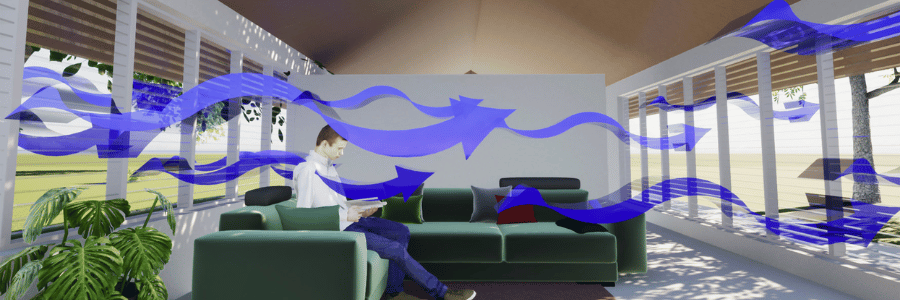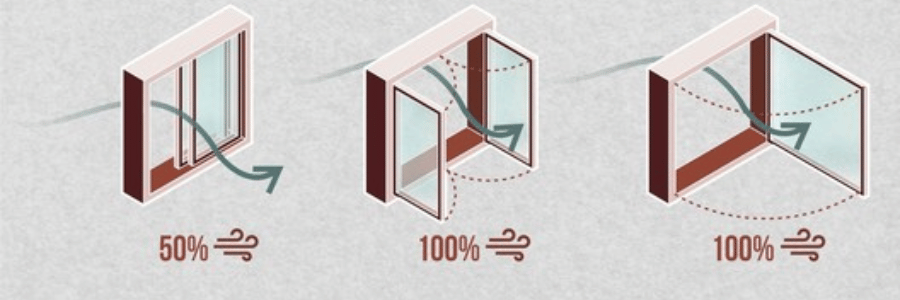Proper ventilation is key to maintaining a comfortable and healthy indoor environment. While air conditioning and fans can keep your home cool, natural ventilation is often more efficient and energy-saving. One of the most effective ways to achieve natural airflow is through cross-ventilation, a technique that uses strategically placed windows to allow air to flow through your home. In this blog post, we will explore the benefits of using windows to create cross-ventilation and how you can make the most of this natural cooling method.

What is Cross-Ventilation?
Cross-ventilation occurs when air flows from one side of your home to the other, creating a natural breeze. This is achieved by opening windows or vents on opposite sides of the room or house. As the air enters one window, it pushes the warmer air out through another, creating a continuous flow of fresh air. This method relies on temperature differences between the inside and outside of your home to facilitate airflow.

Benefits of Cross-Ventilation
Improved Air Quality
One of the primary benefits of cross-ventilation is improved air quality. By allowing fresh air to flow freely through your home, you reduce the buildup of indoor air pollutants such as dust, allergens, and VOCs (volatile organic compounds). Proper ventilation helps maintain a healthier indoor environment, which is especially important for people with allergies, asthma, or respiratory issues.
Energy Efficiency
Using natural airflow to cool your home is an energy-efficient alternative to relying on air conditioning or fans. Cross-ventilation allows you to reduce your reliance on energy-intensive cooling methods, which can lower your electricity bills. Opening windows on cooler mornings and evenings can allow fresh air to flow through, cooling your home without the need for artificial cooling systems.

Temperature Regulation
Cross-ventilation is an effective way to regulate indoor temperatures, especially in the summer months. By creating a consistent flow of air, you can prevent rooms from becoming stuffy and overheated. This can help maintain a comfortable temperature without the need for air conditioning, ensuring that your living spaces stay cool and comfortable.

Reduced Humidity Levels
High humidity can lead to mold growth, unpleasant odors, and discomfort in your home. Cross-ventilation helps to control indoor humidity levels by allowing moist air to escape and drier air to replace it. This is especially beneficial in areas with high humidity, such as bathrooms, kitchens, and basements. Lowering humidity levels helps prevent the growth of mold and mildew, ensuring a healthier living environment.
Enhanced Comfort and Well-Being
Fresh air has a positive effect on your overall well-being. It can improve mood, reduce stress, and boost energy levels. Cross-ventilation helps to circulate fresh air throughout your home, creating a more pleasant and comfortable living environment. Whether you’re working, cooking, or relaxing, having natural airflow can make your home feel more inviting and breathable.

How to Maximize Cross-Ventilation
Position Windows Strategically
To make the most of cross-ventilation, position windows on opposite sides of the room or house. This allows air to flow in through one window and out through another, creating an uninterrupted breeze. For best results, choose windows that can be fully opened to allow for maximum airflow.

Consider Window Type and Size
Different window types offer varying levels of ventilation. For example, casement windows can be fully opened to allow maximum airflow, while sliding windows might only open halfway. Larger windows provide more airflow, so consider installing bigger windows or adding additional windows in key areas of your home to enhance cross-ventilation.
Use Window Screens
Window screens are essential for maintaining cross-ventilation while keeping insects and debris out. Installing high-quality screens on your windows ensures that you can keep your windows open without worrying about pests. This is especially important if you plan to use cross-ventilation during the warmer months when insects are more active.

Take Advantage of Natural Airflow Patterns
In some cases, the natural direction of the wind can work in your favor. By opening windows on the windward side of your home and ensuring that air can exit from the leeward side, you can harness the power of the breeze to enhance airflow. Understanding your home’s position and natural wind patterns can help you optimize cross-ventilation.

Use Interior Doors to Help Airflow
In addition to opening exterior windows, consider opening interior doors to allow air to move freely between rooms. This helps create a more consistent flow of air throughout your home, making cross-ventilation even more effective.

Conclusion
Cross-ventilation is a simple, effective, and energy-efficient way to maintain a comfortable indoor environment. By using windows strategically, you can improve air quality, regulate temperature, and reduce humidity, all while lowering your energy costs. Whether you’re looking to cool your home naturally or improve indoor air circulation, cross-ventilation offers a range of benefits that can enhance your overall comfort and well-being.
By taking advantage of the natural airflow and positioning windows for maximum ventilation, you can create a fresh, comfortable atmosphere in your home without relying on air conditioning. So, open those windows and let the fresh air in—your home will thank you!



